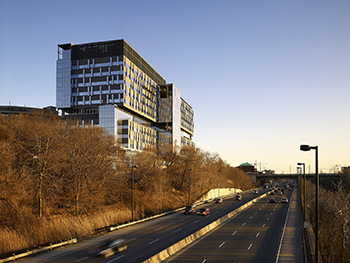Patient Rehabilitation Expands in Canada
 TORONTO — Bridgepoint Active Healthcare’s new patient rehabilitation center — the largest health care facility of its kind in Canada — opened in Toronto on June 25.
TORONTO — Bridgepoint Active Healthcare’s new patient rehabilitation center — the largest health care facility of its kind in Canada — opened in Toronto on June 25.
Based on a master plan developed by Toronto-based Urban Strategies, the project was designed and constructed by Stantec Architecture/KPMB Architects, which served as the Planning, Design and Compliance Architects, and HDR Architecture/Diamond Schmitt Architects, the Architects of Record.
The project was designed using the same concept of the recently opened Spaulding Rehabilitation Hospital. It provides an ideal rehabilitative environment by incorporating the community and giving patients access to nature. The community was especially involved with the Bridgepoint project because of the renovation of the adjacent pre-Confederation Don Jail, which will serve as the hospital’s administrative offices.
The 464-bed hospital is a replacement facility that was necessary for Bridgepoint to increase acuity for patients. The previous hospital had about 550 square feet per patient, according to Stuart Elgie, principal at Stantec Architecture. “General standards would say that hospitals in that area would have about 1,100 square feet per patient, and the facilities were not near current standards,” Elgie said.
The hospital is situated right on the edge of the Don Valley. “The hospital was very keen on staying on that site,” Elgie said. “Properly connecting to that site was really important to their patients and where they wanted to take health care delivery.”
The design incorporated a park that spills into the hospital, inviting the community inside and giving patients a connection to both nature and the outside world. “It’s all about getting [the patients] back into the community and back into their homes and normalizing life for them,” Elgie said.
“There’s lots of proven documentation that people get better when they have natural light and nature. With that brings generally more positive patient outcomes,” he said. “That connection to landscape and nature was the single biggest design objective that our project met.”
The therapy pool on the north end of the hospital, for instance, is nestled within this public park, with lots of glass opening into the park. Above the pool is a therapeutic labyrinth, which accommodates the hospital’s idea of graduated rehabilitation to provide different levels access to nature. On the 10th floor, patients can see views of Ontario and the downtown core. “Ultimately, it’s about providing a sense of normalcy and doing it in a way that helps support patients that desire to get better,” Elgie said.
For patients that are not able to leave their room, the natural setting is also brought into each individual room by allowing patients to have unobstructed views from their window.
The major challenges on the project involved the site because it was a very tight space that required efficient planning for a tight building envelope. Plus, with the restoration of the Don Jail and the project’s involvement in the community, there were several municipal approvals needed that took an extensive amount of time.
While the hospital is operational, there are still significant processes underway. The old hospital needs to be demolished and the Toronto jail, also on the site, has to be demolished. There are still extensive site works that need to be completed. That work should be done in about a year, Elgie said.
